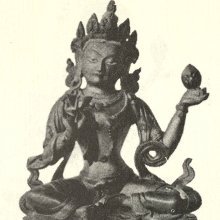Padmadakini, Padmaḍākinī, Padma-dakini: 2 definitions
Introduction:
Padmadakini means something in Buddhism, Pali, Hinduism, Sanskrit. If you want to know the exact meaning, history, etymology or English translation of this term then check out the descriptions on this page. Add your comment or reference to a book if you want to contribute to this summary article.
Images (photo gallery)
In Buddhism
Tibetan Buddhism (Vajrayana or tantric Buddhism)
Source: archive.org: The Indian Buddhist IconographyPadmaḍākinī (पद्मडाकिनी) refers to one of the four deities situated in the four petals in the four cardinal directions of the mahāmāyāmaṇḍala, according to in the 5th-century Sādhanamālā (a collection of sādhana texts that contain detailed instructions for rituals).—Ratnaḍākinī is described in the mahāmāyāmaṇḍala as follows: “[...] the four petals in the four cardinal directions of the lotus seat are occupied by the following goddesses:—(3) Padmaḍākinī in the west is of reddish white colour, has four faces of red, yellow, blue and green colour, and carries the bow and the kapāla in her two left hands and the arrow and the double lotus in the two right. [...] These four deities [viz., Padmaḍākinī] exhibit wrath, have their heads decorated with a number of skulls, have garlands of heads still wet with blood, three eyes and portruding teeth. Their brown hair stream upwards in the shape of a flame, and flames of fire radiate from their persons”.

Tibetan Buddhism includes schools such as Nyingma, Kadampa, Kagyu and Gelug. Their primary canon of literature is divided in two broad categories: The Kangyur, which consists of Buddha’s words, and the Tengyur, which includes commentaries from various sources. Esotericism and tantra techniques (vajrayāna) are collected indepently.
Languages of India and abroad
Sanskrit dictionary
Source: Cologne Digital Sanskrit Dictionaries: Edgerton Buddhist Hybrid Sanskrit DictionaryPadmaḍākinī (पद्मडाकिनी).—name of a yoginī: Sādhanamālā 460.4 etc.
Sanskrit, also spelled संस्कृतम् (saṃskṛtam), is an ancient language of India commonly seen as the grandmother of the Indo-European language family (even English!). Closely allied with Prakrit and Pali, Sanskrit is more exhaustive in both grammar and terms and has the most extensive collection of literature in the world, greatly surpassing its sister-languages Greek and Latin.
See also (Relevant definitions)
Partial matches: Padma, Dakini, Takini.
Full-text: Mahamayamandala.
Relevant text
Search found 1 books and stories containing Padmadakini, Padmaḍākinī, Padma-dakini, Padma-ḍākinī; (plurals include: Padmadakinis, Padmaḍākinīs, dakinis, ḍākinīs). You can also click to the full overview containing English textual excerpts. Below are direct links for the most relevant articles:
The gods of northern Buddhism (by Alice Getty)
